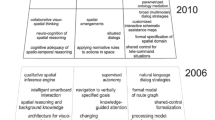Abstract
The Transregional Collaborative Research Center SFB/TR 8 Spatial Cognition pursues interdisciplinary research on a broad range of topics related to the representation and processing mechanisms for intelligent spatial behavior in technical and in natural systems. This contribution gives an overview of the field of research worked on in the SFB/TR 8 Spatial Cognition and presents three representative examples that illustrate the activities in the three research areas Reasoning, Action, and Interaction.


Similar content being viewed by others
References
Barkowsky T (2007) Modeling mental spatial knowledge processing: an AI perspective. In: Mast FW, Jäncke L (eds) Spatial processing in navigation, imagery, and perception. Springer, New York, pp 67–84
Bateman JA, Hois J, Ross RJ, Tenbrink T (2010) A linguistic ontology of space for natural language processing. Artif Intell 174:1027–1071
Bertel S, Barkowsky T, König P, Schultheis H, Freksa C (2006) Sketching mental images and reasoning with sketches: NEVILLE—a computational model of mental & external spatial problem solving. In: Fum D, del Missier F, Stocco A (eds) Proceedings of the 7th international conference on cognitive modeling, Trieste (ICCM 2006). Edizioni Goliardiche, Trieste, pp 349–350
Cuayáhuitl H, Renals S, Lemon O, Shimodaira H (2010) Evaluation of a hierarchical reinforcement learning spoken dialogue system. Comput Speech Lang 24(2):395–429
Habel C, Eschenbach C (1997) Abstract structures in spatial cognition. In: Freksa C, Jantzen M, Valk R (eds) Foundations of computer science: potential–theory–cognition. Springer, Berlin, pp 369–378
Habel S, Werner S (1999) Special issue on spatial reference systems. Spat Cogn Comput, 4(1)
Hoare CAR (1985) Communicating sequential processes. Prentice Hall, New York
Hölscher C, Buechner SJ, Meilinger T, Strube G (2009) Adaptivity of wayfinding strategies in a multi-building ensemble: the effects of spatial structure, task requirements and metric information. J Environ Psychol 29(2):208–219
Knauff M, Rauh R, Schlieder C (1995) Preferred mental models in qualitative spatial reasoning: a cognitive assessment of allen’s calculus. In: Proceedings of the seventeenth annual conference of the cognitive science society. Erlbaum, Hillsdale, pp 200–205
Montello DR (1993) Scale and multiple representations of space. In: Frank AU, Campari I (eds) Spatial information theory—a theoretical basis for GIS (COSIT’93). Springer, Berlin, pp 312–321
Piaget J, Inhelder B (1956) A child’s conception of space. Routledge & Kegan Paul, London
Ross R, Shi H, Vierhuff T, Krieg-Brückner B, Bateman J (2005) Towards dialogue based shared control of navigating robots. In: Freksa C, Knauff M, Krieg-Brückner B, Nebel B, Barkowsky T (eds) Spatial cognition IV: reasoning, action, interaction. Springer, Berlin/Heidelberg, pp 478–499
Schill K, Zetzsche C, Hois J (2009) A belief-based architecture for scene analysis: from sensorimotor features to knowledge and ontology. Fuzzy Sets Syst 160(10):1507–1516
Schultheis H, Barkowsky T, Bertel S (2006) LTM-C—an improved long-term memory for cognitive architectures. In: Fum D, del Missier F, Stocco A (eds) Proceedings of the 7th international conference on cognitive modeling, Trieste (ICCM 2006). Edizioni Goliardiche, Trieste, pp 274–279
Schultheis H, Bertel S, Barkowsky T, Seifert I (2007) The spatial and the visual in mental spatial reasoning: an ill-posed distinction. In: Barkowsky T, Knauff M, Ligozat G, Montello DR (eds) Spatial cognition V: reasoning, action, interaction. Springer, Berlin, pp 191–209
Sloman A (1975) Afterthoughts on analogical representations. In: Proc theoretical issues in natural language processing, pp 164–168
Tenbrink T (2007) Space, time, and the use of language: an investigation of relationships. Mouton de Gruyter, Berlin
Tenbrink T, Ross RJ, Thomas K, Dethlefs N, Andonova E (2010) Negotiating routes in map-based human-human and human-computer dialogue: a comparative analysis. J Vis Lang Comput. doi:10.1016/j.jvlc.2010.07.001
Zetzsche C, Wolter J, Galbraith C, Schill K (2009) Representation of space: image-like or sensorimotor. Spat Vis 22(5):409–424
Acknowledgements
We gratefully acknowledge the funding of the SFB/TR 8 Spatial Cognition by the German Research Foundation (DFG), and we thank our project collaborators for their contributions.
Author information
Authors and Affiliations
Corresponding author
Rights and permissions
About this article
Cite this article
Freksa, C., Schultheis, H., Schill, K. et al. Spatial Cognition: Reasoning, Action, Interaction. Künstl Intell 24, 329–334 (2010). https://doi.org/10.1007/s13218-010-0055-x
Published:
Issue Date:
DOI: https://doi.org/10.1007/s13218-010-0055-x




